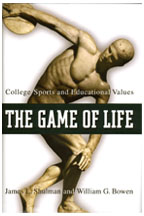|
February 21, 2001: From the Editor "Some of the members
of the Princeton University Band Council have gone out of their
minds and want to enter the band in the marching competition at
the Rose Bowl next year. I put a stop to that both in terms of the
exorbitant expense and in terms of our reluctance to become involved
in any way with commercialized athletics." -- from the diary
of Dean of Students Bill Lippincott '41 in the late 1950s In the decade following
Dean Lippincott's diary entry, Princeton would celebrate its
ascension to men's basketball's hallowed Final Four. In
the decades following that, the Tigers would rack up repeated national
championships in both men's and women's sports ranging
from crew to lacrosse to soccer. Today, Princeton's
men's basketball team wears Nike's swoosh while its squash
teams play only with Prince. Cheerleaders fire T-shirts sponsored
by local businesses into crowds. Football halftime contests give
fans a chance to punt, pass, and kick their way to a brand-new car.
Commercialized athletics, it seems, are here to stay.
The alumni featured in
our cover story, all but one of whom are former Princeton athletes,
might disagree. But, as Bowen and Shulman show, Princeton is hardly
immune to the problems and questions that swirl around higher education,
sports, and money. In fact, The Game of Life uses as one of four
introductory anecdotes Princeton's controversial 1993 decision
to discontinue wrestling. (PAW's excerpt begins on page 18.)
Clearly, Dean Lippincott saw it coming.
|

 In
this annual business and economics issue, PAW takes a look at the
economics of sports at both levels. The cover story, which features
alumni working as executives in pro leagues around the country,
was planned some time ago, and interviews were well under way late
this fall when, coincidentally, an advance copy of a book called
The Game of Life showed up in the mail. Written by former President
William G. Bowen *58 and James Shulman, The Game of Life
-- which the New Yorker said "may be one of the most important books
on higher education published in the last 20 years" and Sports Illustrated's
Frank Deford '61 called possibly "the most important book about
sports of this generation" -- argues that college sports may not
be worth their price.
In
this annual business and economics issue, PAW takes a look at the
economics of sports at both levels. The cover story, which features
alumni working as executives in pro leagues around the country,
was planned some time ago, and interviews were well under way late
this fall when, coincidentally, an advance copy of a book called
The Game of Life showed up in the mail. Written by former President
William G. Bowen *58 and James Shulman, The Game of Life
-- which the New Yorker said "may be one of the most important books
on higher education published in the last 20 years" and Sports Illustrated's
Frank Deford '61 called possibly "the most important book about
sports of this generation" -- argues that college sports may not
be worth their price. 